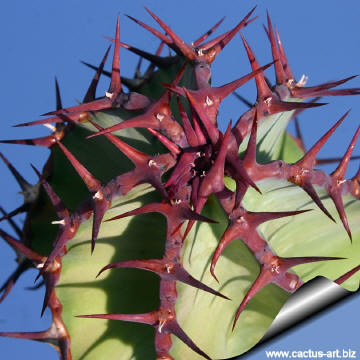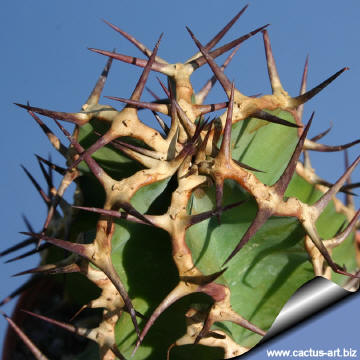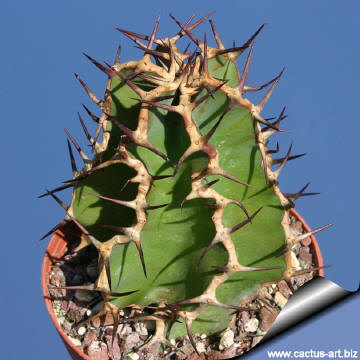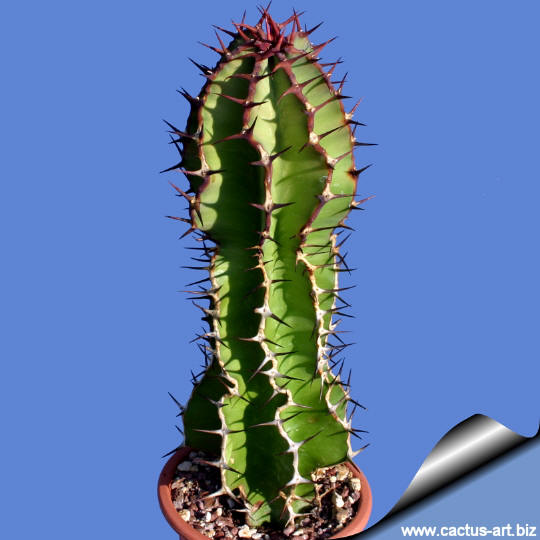|
|
|

Euphorbia
avasmontana
The spines are found in pairs and form a spiky margin along each
ridge on the branches. The outer rib-ridges have continuous, narrow and
dark spine shields running along them. |
|
Description: Many-stemmed, spiny, columnar cactus-like succulents
branching at the base, 2-2,5 m tall that can sucker to nearly as wide
with milky latex. It is one of many South African Euphorbias that at
fist glace look a lot like each other. Very neat habit and makes a good
specimen landscape plant in a xeriscape garden.
Stems: Rarely re-branched 6-7 cm in diameter irregularly
constricted at variable intervals (approx 10-15 cm).
Ribs: 5-7, with shallow furrows, ± 1 cm apart
Leaves: Only present on young growth on most months.
Stipular spines: Straight, paired, joined in a horny margin,1-2
cm long running up and down the full length of the columnar growths.
Flowers: 2–3 cymes with small (Ø 8 mm) yellow cyathia in a
horizontal line, borne between spine-pairs, leaving 2–3 small scars when
they fall. Nectar gland, oblong, touching, yellow.
Blooming season (Europe): Mostly in spring and autumn, but other
months as well.
Fruits: Distinctly three-angled capsules up to 6 mm wide.
Seed: Globose 1,7 mm in diameter, smooth.
May easily be confused with E. virosa and other large
euphorbias, and are therefore probably underrecorded. The differences
lie in the number of scars left by the cyathia when they fall, the shape
of the capsule, and the shape and branching of the stem.
|

Active growing phase (Early spring to late summer) |

Resting phase (Autumn to late winter) |
|

It is characterized by periods of rapid growth, designated by the wide
sections, and minimal growth which are the narrow sections.
|

Spines are straight, paired, joined in a horny margin,1-2 cm long
running up and down the full length of the columnar growths.
|
|
Advertising
|
|
|
|
|
|
|
Family: Euphorbiaceae
Accepted
scientific name: Euphorbia
avasmontana Dinter
In: Repert. Spec. Nov.
regni. Veg. Beih. 2:96, 1928
Common English Names include: Crown of Thorns, Slender
Candelabra euphorbia
Origin: Fairly widely scattered throughout South Africa on bolth
sides of orange river (Namaqualand, Bushmanland ) and Namibia
Habitat: It is an opportunistic grower,
common to locally abundant on hill slopes, uncommon on rocky outcrops;
occasionally found on hilltops and in other habitats. Often growing
along with
Aloe dichotoma. Annual rain fall varies from 150 to 300 mm
Conservation status: Listed in
CITES appendix 2.
Synonyms:
- Euphorbia kalaharica Marloth 1930
- Euphorbia karasmontana
|
|
|
|

Cultivation: It is an easy species to grow that is suited for any
well drained soil in full sun. But young plant are happy growing
indoors. Give the plant an airy growing medium which mainly consists of
non organic material such us clay, pumice, lava grit, and only a little
peat or leaf-mould. Water regularly during the active growing season
from March to September. No water should ever be allowed to stand around
the roots. Keep almost completely dry in winter. It is a moderately fast
grower, and will quickly become large landscape masterpieces in just
5-10 years. Only downside is from strong winds, the columns often smash
into each other, causing permanent scarring... best to plant in such a
location where winds are not a big issue. It is a long lived plant
and once established, it will be content in its position and with its
soil for years. It can tolerate moderate shade, and a plant that has
been growing in shade should be slowly hardened off before placing it in
full sun as the plant will be severely scorched if moved too suddenly
from shade into sun. Like quite small pots, repot in very later winter,
early spring. Frost tender, frost free zones only.
Propagation: It is
easy to propagate by cuttings in late spring to summer, just take
a cutting of the plant let it dry for 1 or 2 weeks and stuff it in the
ground (preferably dry, loose, extremely well draining soil).
Warning: Its latex is
reputed the most poisonous in all of the species. Can irritate the skin
even if there is proximity and no actual contact, a slight smear on the
skin or face produces blisters and inhalation of the air close to a
bleeding plant can produce a burning sensation in the throat. Latex
irritates the eye and can cause blindeness. If contact is made with this
white sap, take care to not touch face or eyes before washing hands with
soap and water.
Traditional uses:
Fishing: It is used to stupefy fish, making it possible to catch
them by hand. The fish poison is prepared by soaking a bundle of grass
in the latex, tying it to a stone and throwing it into the water.
Paralysed fish rise to the surface within a short period of time.
Gardening: This tree can be grown in large, rocky, well-drained
soil in gardens in drier areas, however, because of the latex and
spines, is not advisable for a family garden. It is very drought
resistant but susceptible to frost.


|
|